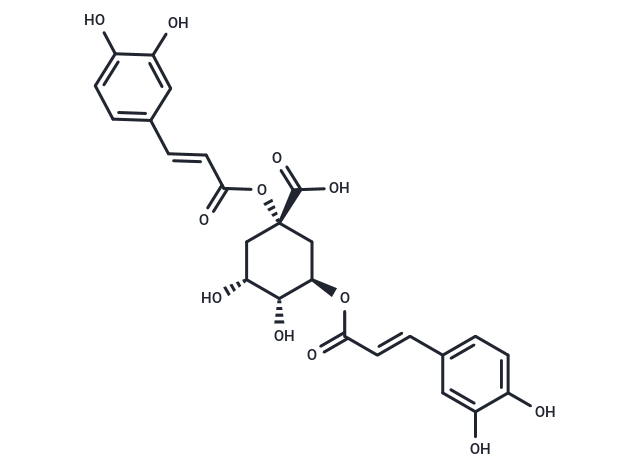Shopping Cart
- Remove All
 Your shopping cart is currently empty
Your shopping cart is currently empty

1,3-Dicaffeoylquinic acid (CYNARIN) is a natural product. It shows antioxidant and choleretic properties and is a potential immunosuppressive agent.

| Pack Size | Price | Availability | Quantity |
|---|---|---|---|
| 20 mg | $140 | In Stock | |
| 1 mL x 10 mM (in DMSO) | $110 | In Stock |
| Description | 1,3-Dicaffeoylquinic acid (CYNARIN) is a natural product. It shows antioxidant and choleretic properties and is a potential immunosuppressive agent. |
| In vivo | CYNARIN have neuroprotective effects.CYNARIN prevents Aβ(42)-induced neurotoxicity through the activation of PI3K/Akt followed by the stimulation of Trk A, then the inhibition of GSK3β as well as the modulation of Bcl-2/Bax. |
| Animal Research | The neuroprotective effects of 1,5-DQA against amyloid β(1-42) (Aβ(42))-induced neurotoxicity in primary neuronal culture. To evaluate the neuroprotective effects of 1,5-DQA, primary cultured cortical neurons from neonate rats were pretreated with 1,5-DQA for 2 hours and then treated with 40 μmol/L Aβ(42) for 6 hours. Cell counting kit-8, Hoechst staining and Western blotting were used for detecting the protective mechanism. Comparisons between two groups were evaluated by independent t test, and multiple comparisons were analyzed by one-way analysis of variance (ANOVA). |
| Alias | CYNARIN, Cyclohexanecarboxylic acid, 1,3-bis[[3-(3,4-dihydroxyphenyl)-1-oxo-2-propen-1-yl]oxy]-4,5-dihydroxy-, (1S,3R,4R,5R)-, 1,5-Dicaffeoylquinic acid, 1,3-O-Dicaffeoylquinic acid |
| Molecular Weight | 516.45 |
| Formula | C25H24O12 |
| Cas No. | 19870-46-3 |
| Smiles | O[C@@H]1C[C@@](C[C@@H](OC(=O)\C=C\c2ccc(O)c(O)c2)[C@@H]1O)(OC(=O)\C=C\c1ccc(O)c(O)c1)C(O)=O |
| Relative Density. | 1.64 g/cm3 |
| Storage | keep away from moisture | Powder: -20°C for 3 years | In solvent: -80°C for 1 year | Shipping with blue ice. | |||||||||||||||||||||||||
| Solubility Information | DMSO: 23 mg/mL (44.53 mM), Sonication is recommended. | |||||||||||||||||||||||||
Solution Preparation Table | ||||||||||||||||||||||||||
DMSO
| ||||||||||||||||||||||||||

Copyright © 2015-2025 TargetMol Chemicals Inc. All Rights Reserved.